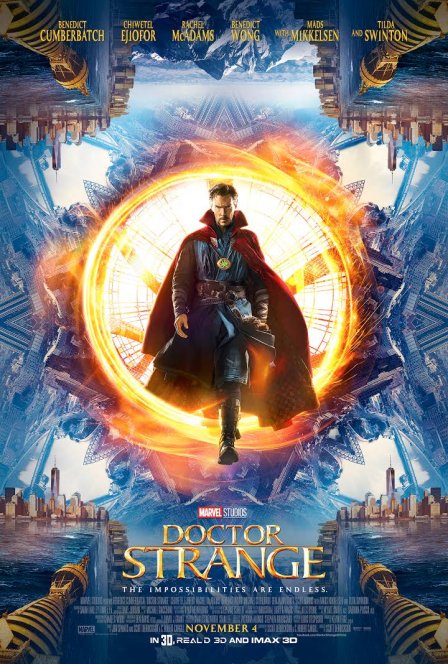While it should be enough to see people flying, untold new worlds being explored, and amazing feats of strength, too often modern blockbusters have been lackluster in the spectacle department. Part of it is that audiences have become bored by seeing the same color palette and destruction porn in their massive movies, remaining unimpressed by CGI shots of cartoon superheroes zooming through the skies or picking up other CGI objects like they were nothing. But part of it is that filmmakers haven’t been willing (or allowed) to push the boundaries of the visual medium with their explorations of a heightened reality, always grounding it in the mundane to make it seem more “real” to viewers. Luckily, Scott Derrickson’s Doctor Strange has come along to shake things up and finally push the special effects and imagery of a comic book blockbuster into a realm of awe-inducing sights. And while the story is a bit hampered by its own too familiar comic book origins and plotting, there is still enough charisma and charm in the script to support the grand designs feeding the eyes. It may not be the best Marvel film ever made, but Derrickson’s movie is certainly the most visually daring.
Doctor Strange is the origin story of the titular egotistic neurosurgeon who loses his ability to perform surgery, and seeks out answers in the Far East to gain insight and a chance at a second life. Benedict Cumberbatch stars as the spoiled man who learns humility and sacrifice from his compatriots Mordo (Chiwetel Ejiofor) and Wong (Benedict Wong) as well as from his master, The Ancient One (Tilda Swinton). He also learns how to cast spells and bend the rules of what is imagined as possible, which will come in handy when he and the other sorcerers must band together to fight the evil Kaecilius (Mads Mikkelsen) and a group of zealots intent on bringing about the end of the world.
The story of an egomaniac brought low by events and finding a new, heroic path has been explored in many other tales— — Marvel ones, like Iron Man, which follows a very similar character trajectory. But what makes this movie by Derrickson (Sinister) and screenwriters Jon Spaihts and C. Robert Cargill really work is the stunning display of audacity in its visuals. Some parts feel like a kaleidoscopic mash-up of fractals, Inception, and Dark City, while others look like a psychedelic black light poster brought to life. In a rubble-strewn world of disaster fetishism in modern blockbuster filmmaking, with its drab shots and forgettable framework, Doctor Strange truly stands out for constantly being inventive in its depiction of a magical crossroads and staging of mystical fighting. For those looking for a point of comparison in recent films, besides the previous two mentioned, the last part of Ant-Man delved into this bizarre, comic book aesthetic when Scott Lang went subatomic and fell into a world of pure math and bizarre angles. Now imagine a movie where entire fight sequences use that same esoteric imagery and the film is constantly unfolding in spectacular special effects, and that’s close to the visual wizardry (pun slightly intended) on display.
Visuals alone are not enough to carry a movie, even if they are perhaps the most impressive shift since The Matrix. The narrative itself is a bit dry and covers well-worn territory — and it also has some cultural baggage as once again a white messiah goes to the East to become better at the eastern traditions than others. But what makes the script work so well is the amount of charming moments there are between characters, the humor and humanity involved in most scenes. Cumberbatch is good (though his accent is a bit wonky) as the doctor, trading witty barbs with everyone as he continually holds himself up above it all (until, spoiler alert, he doesn’t). However, the supporting players each have a lot to offer, whether it’s the ethereal Swinton as the Ancient One, a perfect bit of casting (white washing aside) as she embodies a real sense of otherness that sets her apart from humanity. Or Ejiofor as Mordo, the ardent and hardlined mystical warrior that comic book readers will know what becomes of him, but general audiences will be intrigued by his natural progression of character. The always great Mads Mikkelsen continues his impressive filmography with his performance, one that could’ve easily been written off as a disposable Marvel villain, but is filled with real humanity and an inherently intriguing motivation that makes him compelling to watch. The cast and script shines brightest not when discussing the mystical mumbo jumbo, or just when trading quips back and forth, but also when discussing actual character goals and drives that makes them seem more rounded than the usual comic book fare. Sadly, though, Rachel McAdams as Palmer, Strange’s would-be romantic partner, is mostly used just for gags and in a useless romantic subplot that could be excised without much problem.
Since its inception in the comics, Doctor Strange has always been one of the most out there and psychedelic properties Marvel produced, with work by Steve Ditko and others to create impossible new realms on the page that dazzle the eye and boggle the mind. It’s a true testament to the excellent filmmaking of Doctor Strange that not only has the same visual bravado of the comics survived to the screen, but it also comes with some excellent character work and memorable scenes. Previously Ant-Man and Guardians Of The Galaxy were the only two of the oft reviled “comic book movies” that embraced narrative conventions while shrugging off boring aesthetics, all infused with real personality and great characters. Doctor Strange now makes it a trio and opens up a whole new world that audiences will want to explore often, enjoying the adventure and all the great sights to see.

